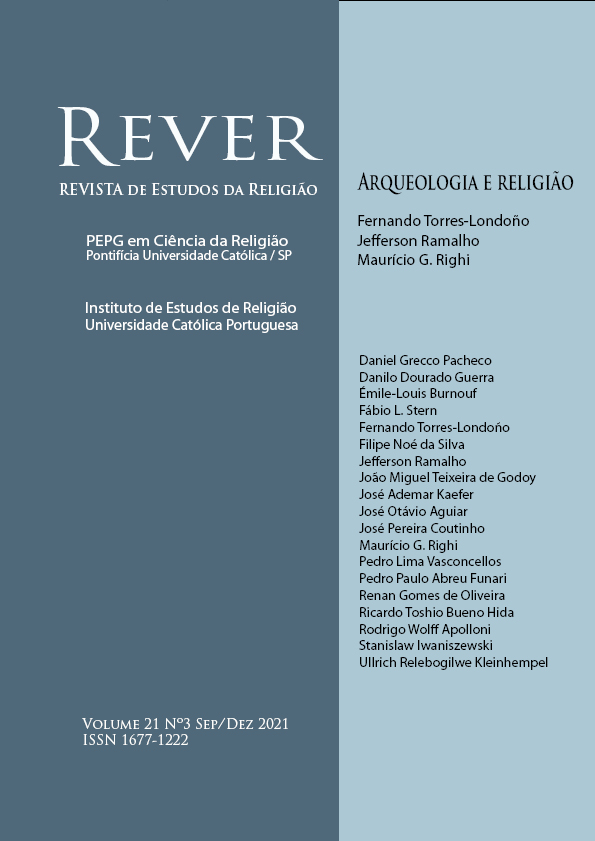Do rito ao cânone
Arqueologia da religião em três perspectivas
DOI:
https://doi.org/10.23925/1677-1222.2021vol21i3a2Palavras-chave:
Religião, Poder, Rito, Cultura material, CanonicidadeResumo
O presente artigo, escrito a seis mãos tem por objetivo traçar um recorte interdisciplinar e transdisciplinar, no que inclui perspectivas arqueológicas, históricas e antropológicas, em diálogo com a ciência da religião, em uma análise de cenários consideravelmente distantes um do outro. Um olhar no contexto pré-histórico da religião no sítio neolítico em Çatalhöyük, a problematização dos textos hebreus a partir de uma atenção dedicada à cultura material, as recepções dos primeiros textos cristãos em diferentes fontes arqueológicas da Antiguidade Tardia e a aplicação da ideia de canonicidade ao contexto xamânico amazônico são as abordagens temáticas que aqui se propõem, evidenciando eixos teóricos comuns, apesar das distâncias e diferenças entre os objetos, que seriam o eixos das relações entre religião e poder, e entre oralidade, escrita, imagem e canonicidade.
Referências
BURKERT, W. Homo Necans: The Anthropology of Ancient Greek Sacrificial Ritual and Myth. Berkeley, CA: University of California Press, 1983.
CHEVITARESE, A. L. Cristianismos: questões e debates metodológicos. Rio de Janeiro: Kliné, 2011.
CHEVITARESE, A. L. Jesus no evangelho do Discípulo que Jesus Amava: a experiência cotidiana numa antiquíssima comunidade cristã. Osasco: Ramalho, 2019.
FERRIS, I. The Arch of Constantine: Inspired by the Divine. Stroud: Amberley, 2013.
FINKELSTEIN, I; SILBERMAN, N. A. A Bíblia desenterrada: a nova visão arqueológica do antigo Israel e das origens dos seus textos sagrados. Petrópolis, RJ: Vozes, 2018.
FOUCAULT, M. As palavras e as coisas: uma arqueologia das ciências humanas. 2ed. São Paulo: Martins Fontes, 1981.
FREEMAN, C. A New History of Early Christianity. New Haven/London: Yale University Press, 2009.
GIRARD, R. A Violência e o Sagrado. Rio de Janeiro: Paz e Terra, 1998.
GUNNEWEG, A. H. J. História de Israel: dos primórdios até Bar Kochba e de Theodor Herzl até os nossos dias. São Paulo: Teológica/Loyola, 2005.
HAYDEN, B. “A Prolegomenon to the Importance of Feasting” In: DIETLER M; HAYDEN B. (eds.) Feasts: Archaeological and Ethnographic Perspectives on Food, Politics, and Power. Tuscaloosa, AL: The University of Alabama Press. 2001.
HODDER, I. (ed.). Religion in the Emergence of Civilization: Çatalhöyük as a Case Study. New York: Cambridge University Press, 2010.
HODDER, I. (ed.). Religion at Work in a Neolithic Society. Cambridge: Cambridge University Press, 2014.
JEFFERSON, L. M. “The Staff of Jesus in Early Christian Art”. In: Religion and the Arts. 14, 2010, pp. 221-251.
KOPENAWA, D; ALBERT, B. A queda do céu. Palavras de um xamã Yanomami. São Paulo: Companhia das Letras, 2015.
MILLS, B. J. Relational Networks and Religious Sodalities at Çatalhöyük. In: HODDER, Ian (ed.). Religion at Work in a Neolithic Society. Cambridge: Cambridge University Press, 2014.
PELS, P. Temporalities of ‘Religion’ at Çatalhöyük. In: HODDER, Ian (ed.) Religion in the Emergence of Civilization: Çatalhöyük as a Case Study. Nova York: Cambridge University Press, 2010.
RAMALHO, J. Constantino nas palavras e nas coisas: a (não) cristianização imediata do Império Romano a partir das diferenças e das semelhanças entre representações político-religiosas de fontes literárias e de fontes arqueológicas (312-337). Campinas, SP: Unicamp, 2018.
RANKE, L. V. Geschiten der romanischen Völker von 1494 bis 1514. Leipzig/Berlim: Reimer, 1824.
RIGHI, M. G. Pré-História & História – As Instituições e as Ideias em seus Fundamentos Religiosos. São Paulo: É Realizações, 2017.
SCHMIDT, K. “Beyond Daily Bread: Evidence of Early Neolithic Ritual from Göbekli Tepe”. Neo-Lithics 2 (98), 1998, pp. 1-5.
TRIGGER, B. G. História do Pensamento Arqueológico. São Paulo, Odysseus, 2004.
VEYNE, P. Quando nosso mundo se tornou cristão: 312-394. Rio de Janeiro: Civilização Brasileira, 2010.
VIVEIROS DE CASTRO, E. Metafísicas Canibais: elementos para uma antropologia pós-estrutural. São Paulo: Cosac & Naify, 2015.
VIVEIROS DE CASTRO, E. A inconstância da alma selvagem e outros ensaios de Antropologia. São Paulo: Cosac & Naify, 2002.
VON RAD, G. Teologia do Antigo Testamento. São Paulo: ASTE/Targumim, 2006.
WATKINS, T. “Changing People, Changing Environments: How Hunter-Gatherers Became Communities that Changed the World”. In: FINLAYSON, Bill; WARREN, Graeme (eds.). Landscapes in Transition. Oxford, UK: Oxbow Books, 2010, pp. 106-114.
WHITEHOUSE, H. “Rites of Terror: Emotion, Metaphor and Memory in the Melanesian Initiation Cults”. The Journal of the Royal Anthropological Institute 2 (4), 1996, pp. 703-715.
WITZEL, M. The Origins of the World’s Mythologies. Oxford: Oxford University Press, 2012.
Downloads
Publicado
Como Citar
Edição
Seção
Licença

Este trabalho está licenciado sob uma licença Creative Commons Attribution-NonCommercial 4.0 International License.
Autores que publicam nesta revista concordam com os seguintes termos:
- Autores mantém os direitos autorais e concedem à revista o direito de primeira publicação, com o trabalho simultaneamente licenciado sob a Licença Attribution-NonCommercial 4.0 International, que permite o compartilhamento do trabalho com reconhecimento da autoria e publicação inicial nesta revista.
- Autores têm autorização para assumir contratos adicionais separadamente, para distribuição não exclusiva da versão do trabalho publicada nesta revista (ex.: publicar em repositório institucional ou como capítulo de livro), com reconhecimento de autoria e publicação inicial nesta revista.


